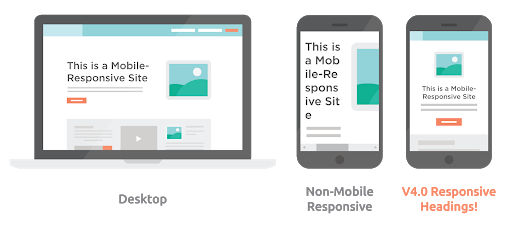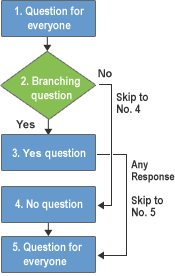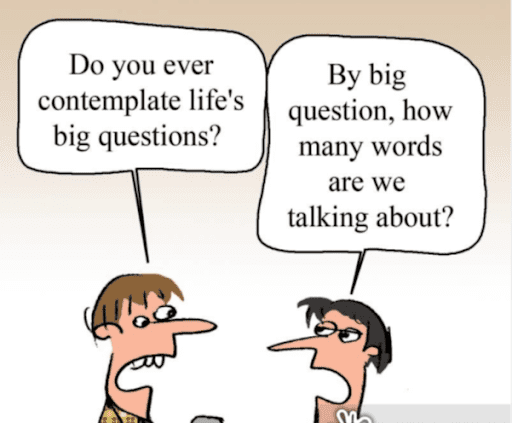
The telephone company solved John’s complaint within 24 hours. Hence, he was more than happy to respond to a follow up customer survey.
Question 1: How would you rate your overall customer service interaction?
{ John gives a five star!}
Question 2: What attributes did you like the most about our customer service representative? (minimum 100 words)
“Oh no! This is too lengthy. I do not have much time to think about this. Let me skip this question. No option to skip? Let me exit the survey!” John thought.
In the above scenario, John was forced to exit the survey because of the necessity to answer a lengthy question. John did not have the time and patience to answer a detailed question that too with a word count of minimum 100 words.. It can happen with any of your customers while they are attempting a survey.
Lengthy, irrelevant, personal, or too many open ended questions, can potentially lead to survey fatigue, high survey exit rates, and poor data collection.
Hence, you need to foresee the most common problems surveys well beforehand and be prepared to tackle them.
This is precisely what we have covered in this blog. After reading this blog, you will get a detailed understanding of ‘how to fix survey problems’.
What are Common Survey Problems?
While creating a survey, your content and design team faces multiple challenges ranging from the type of questions, avoiding survey biases, ensuring the mobile responsiveness of the survey, using the right survey maker tool, and so on.
Let’s have a clear understanding of these problems with surveys.
1. Leading and Loaded Questions
Leading and loaded questions are biased survey questions that confuse or trick the respondents to give a favorable answer. In such a scenario, you receive inaccurate survey responses that fail to give you a clear understanding of your audience’s needs. .
Let’s consider this question:
“What do you think about this amazing event?”
Here, the adjective “amazing” leads the survey respondent to answer in a favorable manner. Even if the respondent did not like the event, they may find it rude to point out the shortcomings.
2. Double-Barreled Questions
Double-Barreled questions consist of two different sub questions combined under a single question. Each of these questions require a different level of thinking and answer.
Let’s understand with the help of an example,
“Do you like tea and coffee?”
This question requires two answers: A respondent’s like/dislike for tea and their like/dislike for coffee. Hence, it is better to split the question into two for better clarity and response.
3. Too Many Demographic Questions
Demographic questions collect the personal information of the target audience like age, income, marital status, religious affiliation, and so on. But, the catch is that too many demographic questions right at the beginning of the survey can seem too much for your target audience to respond. Many of them would have filled the demographic details multiple times. A lot many others would be reluctant to answer personal questions. The key is to strategically place them in the middle and give the option to skip these questions.
Read more: How to Ask Demographic Questions Like a Pro?
4. Poor Mobile Responsiveness of Surveys

Source:Pagebuildersandwich
Did you know that the average response rate of a mobile survey ranges between 30-40%(source)? But, some of the common problems with surveys on the mobile platform is the lack of clarity and responsiveness of the survey, confusion regarding survey navigation tabs, slow image loading, and so on. Additionally, issues with mobile attribution data can further complicate the accuracy and reliability of the results obtained from mobile surveys
Read more: Effective Ways to Improve Your Survey Response Rate
5. Insufficient Response Options
It is observed that many surveys fail to include the right answer options for their audience to choose from. Instead of answering the particular question, your audience either moves to the next question or abandons the survey altogether.
Let’s understand with the help of an example:
“How many years of driving experience do you have?”
- 1-2 years
- 3-5 years
- 7-10 years
If the respondent has 15 years of experience, there is no relevant option to collect their answer. Instead, in this case, an option “10+ years” helps to collect valid responses from the respondents.
6. Negative Worded Questions
Negative worded questions have ‘not’ words attached in the question and they confuse your survey respondents. They could even end up giving a completely opposite answer to the question.
For example, consider the question
“It is not easy for me to interact with the customer service team”
- Agree
- Not Agree
Here, a respondent can be easily confused and choose an unintended answer.
7. Improper Design of Skip Logic

Source: Microsoft
Skip logic type survey question takes the survey respondent to a specific page based on their choice of answer selection. It is an easy way to filter out responses in a survey. But, your skip logic functionality can malfunction, if your customers end up in the same infinite loop and see the non-relevant options.
Let’s understand with the help of an example,
“Are you vegetarian or non-vegetarian?”
- Vegetarian
- Non-Vegetarian
If the respondent selects the option ‘Vegetarian’, they shouldn’t be asked a next question related to meat eating like “Do you like fish or chicken?”. Instead, they should be taken to a page with only vegetarianism related questions. If not, they might find the survey questions irrelevant and exit the survey altogether.
Read more: How to Use Skip Logic in Surveys
8. Too Many Open-Ended Questions

Source: Cartoonstock
Sometimes, while designing survey questions, we tend to create a number of open-ended questions to collect comprehensive feedback from our audience. But, we miss out on the fact that open-ended questions are lengthy and require a lot of time to think and answer. Most of the respondents will be reluctant to continue with the survey due to time constraints.
Read more: What is Survey Fatigue and How to Avoid It?
9. Irrelevant Questions
At times, issues with surveys is that you end up asking irrelevant questions that are completely unrelated to the survey topic. This can irritate your customers resulting in survey abandonment, midway through.
10. Confusing Rating Level Questions
Rating level questions try to understand the opinions of your customers on a wider scale. Usually, we make use of (1-5) scale or (1-7) scale. But, when do rating level questions get confusing?
It gets confusing if the scale is not labeled properly. In that case, some customers can take ‘1’ to mean a low score while others can think it to be a high score.
11. Assuming Prior Knowledge of Your Survey Audience
Not all your survey audience will be aware of the survey topics and ideas behind each survey question. Hence, it is necessary that you use as simple and jargon free language as possible in your survey. Also, ensure that you have familiar survey answer options to make their job easier.
With a clear understanding of common survey mistakes, let’s understand ‘how to avoid survey problems’ in the next section.
Pro-Tips on How to Fix Survey Problems
In this section, let’s understand the tips and tricks to an effective survey design. It is possible by carefully planning the questions, proper placement of questions, limiting the length of the survey, and many more.
- Right Placement of Demographic Questions
You may consider placing the demographic questions to the end of the survey and keep them to a minimum of 3-4. Use the beginning of the survey to ask close-ended and non-personal questions. Once your audience is comfortable, they will answer personal questions.
- Incorporate Clear Response Options
When your audience does not find their desired response option in a survey, they will not be very comfortable in completing the survey. Hence, ensure that you have included all possible response options. There is always a chance of including options like ‘None of the above’ or ‘Prefer not to say’ if you are not clear with the choices of your audience.
- Minimize Open-Ended Questions
Ensure that you limit the open-ended questions to a maximum of 3-4 per survey. Also, keep it at the later part of the survey to avoid survey fatigue and drop out rates. Once your respondents are comfortable with close-ended questions, they will be more willing to attempt the open-ended questions.
Read more: How to Analyze Open-Ended Questions
- Be Clear With the Rating Scale
While framing the survey responses, make sure that it has proper labeling if it is a rating scale question. Otherwise, the survey respondents could get confused and end up giving an inaccurate answer.
For example, on a scale of (1-5), what does one stand for? Is it ‘least likely’ or ‘most likely’? Make sure that you label and clarify it well.
- Effective Planning of Skip Logic
Skip logic errors are one of the biggest problems with online questionnaires. Your survey respondents can easily end up with challenges like getting stuck in a circular loop and skipping to a wrong question. In case of circular logic, your respondents are taken backwards through the survey.
The above mentioned issues can be effectively tackled by reviewing your skip logic questions multiple times. For example, it really helps if you can have a logical flowchart before creating your question. Logical flow charts aid you to systematically analyze the survey logic flow. Also, try to avoid using skip logic multiple times on the same survey page which could lead to confusion.
- Avoid Long Survey Questions
Lengthy survey questions with complex wording can get very challenging for your survey respondents to interpret. Ensure that the questions are direct and precise. Also, stay clear from using technical jargons while using simple language. If you find any survey question to be long and wordy, the best way to shorten it is by paraphrasing it using fewer words.
Read more: How to Create a Simple Knowledge Base for Technical Jargon
Create a Dynamic Survey by Staying Clear of Survey Problems
Survey problems can creep in at any stage of a survey creation. Even after you complete a survey, there are chances of overlooking minor errors like placement of demographic questions, open-ended questions, and more.
The best way to stay clear of survey problems is to review it multiple times both inhouse and externally. Always prefer to ask demographic questions or open-ended questions towards the end of the survey to avoid survey fatigue. Also ensure that you bring in the right survey options so that the respondents do not get confused while attempting the survey.
Looking to create an error-free survey? For that, you need to have access to customized and well designed survey templates. That’s exactly what ProProfs Survey Maker gives you access to.
FREE. All Features. FOREVER!
Try our Forever FREE account with all premium features!

 We'd love your feedback!
We'd love your feedback!
 Thanks for your feedback!
Thanks for your feedback!







